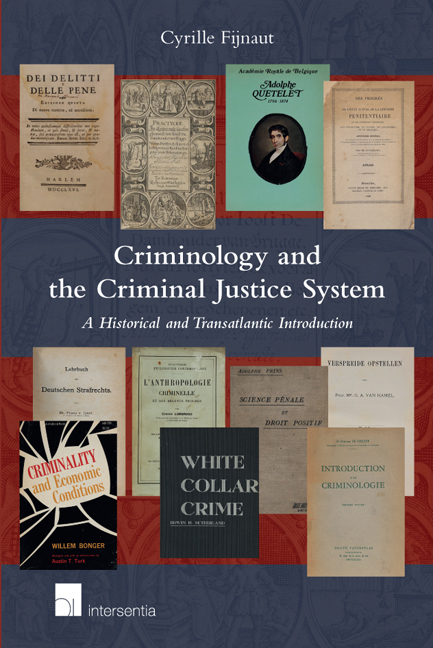Book contents
- Frontmatter
- Preface
- Contents
- Chapter 1 General Introduction
- Chapter 2 Origin of the Present-Day Criminal Justice System
- Chapter 3 Restructuring of the Criminal Justice System During the Enlightenment and the French Period
- Chapter 4 Emergence of the Scientific Study of Crime, Criminals, and the Combatting of Crime
- Chapter 5 Establishment of Criminology in Italy and France
- Chapter 6 Development of Criminology in German-Speaking Europe and the United Kingdom
- Chapter 7 Establishment of Criminology in the Netherlands and Belgium
- Chapter 8 Ideologisation of Criminology in the Third Reich and the Soviet Union
- Chapter 9 Reception of European Criminology in the United States
- Chapter 10 Transatlantic Integration of Criminology
- Chapter 11 General Conclusion
- Bibliography
- Register of Names
Chapter 9 - Reception of European Criminology in the United States
Published online by Cambridge University Press: 11 October 2018
- Frontmatter
- Preface
- Contents
- Chapter 1 General Introduction
- Chapter 2 Origin of the Present-Day Criminal Justice System
- Chapter 3 Restructuring of the Criminal Justice System During the Enlightenment and the French Period
- Chapter 4 Emergence of the Scientific Study of Crime, Criminals, and the Combatting of Crime
- Chapter 5 Establishment of Criminology in Italy and France
- Chapter 6 Development of Criminology in German-Speaking Europe and the United Kingdom
- Chapter 7 Establishment of Criminology in the Netherlands and Belgium
- Chapter 8 Ideologisation of Criminology in the Third Reich and the Soviet Union
- Chapter 9 Reception of European Criminology in the United States
- Chapter 10 Transatlantic Integration of Criminology
- Chapter 11 General Conclusion
- Bibliography
- Register of Names
Summary
INTRODUCTION
The history of criminology in the United States has so far received little attention from either criminologists or historians. No more or less cohesive, lengthy, or detailed and thorough history has yet been written. There are, of course, all sorts of separate publications in which certain developments or certain episodes are discussed to a greater or lesser degree. There are also editions of sources that are useful for getting an idea of this history. This serious lack of historicalcriminological research is in fact recognised in the United States itself.
This means that it is doubly difficult to deal with the history of criminology in the United States until the 1960s in the framework of an introduction in which one is attempting not only to do justice to the transatlantic dimension in the history of the criminology, but also to explore the interaction between criminology, the criminal law, and the criminal justice system in that country. It is nevertheless very important to attempt to obviate that lack and one-sidedness of the standard European and American introductions to criminology.
In the previous chapters of the present work, attention was repeatedly drawn to the interaction between developments in Europe and the United States as regards the criminal justice system. Until late in the nineteenth century, that interaction mainly involved the design of the prison system. There was, for example, the discussion in Europe in response to the conflicting views in the United States as to whether the Pennsylvania or Auburn system was preferable. Similarly, one should not overlook the conference on penitentiary matters in London in 1872 – organised by Enoch Wines, the head of the New York Prison Association – which was the first in a long series of transatlantic conferences under the auspices of the International Penitentiary Commission.
Moreover, we have already seen that in the first half of the twentieth century European researchers and policymakers cited not only European but also American literature in support of their views and proposals. Until into the 1930s, a few of them even crossed the Atlantic specifically to take an on-the-spot look at certain developments in the United States.
- Type
- Chapter
- Information
- Criminology and the Criminal Justice SystemA Historical and Transatlantic Introduction, pp. 355 - 462Publisher: IntersentiaPrint publication year: 2017



